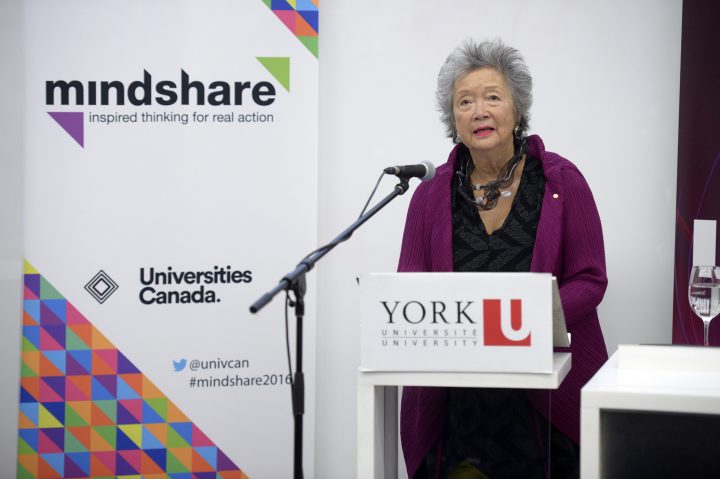
Imagining ways to make Canada a better home for refugees
The Mindshare speaker series, hosted by universities across Canada in 2016 to promote action-oriented policy dialogue, came to York this month. The sizeable crowd attending the York Glendon campus event was invited to “Re-Imagine Refuge”: to examine the status quo and find ways to make life better for the many forced migrants who have arrived in Canada via Syria and other regions of conflict. Despite Canada’s recent and highly publicized resettlement of 25,000 Syrian refugees, the speakers agreed – more can be done. It was underscored that the post-settlement period, while often less flashy, is where a lot of new ideas and practical endeavours are needed as this is where the hard work of welcoming refugees begins.
Former Governor General Adrienne Clarkson, herself a refugee from Hong Kong, opened the event with a keynote acknowledging the communal spirit of many Canadians willing to help, while also observing that many refugees are living in conditions of indignity and isolation. “Canada is full of warm feelings. But we also need practical actions.” Ms. Clarkson suggested that two urgent priority areas are making family re-unification more feasible and removing barriers to the recognition of foreign work credentials. As she put this latter point, “getting people certified and their credentials recognized is an essential part of creating a sense of belonging.”
A panel discussion followed featuring three Toronto professionals all doing innovative work with refugees and refugee scholarship: Jennifer Hyndman, Director of the Centre for Refugee Studies at York; Mary Jo Leddy, founder of Romero House; and Loly Rico, Co-Director of FCJ Refugee Centre and President of Canadian Council for Refugees. As pointed out by Jennifer Hyndman, this year some Syrian refugee children turn 5, and for them the precarious nature of refugee camps is all they’ve ever known, indicating significant dysfunction in the international refugee regime. Meanwhile, although Canada has resettled many refugees, we are also down from 3rd in the world to 16th for asylum seeker reception. Dr. Hyndman asks how we can create more effective empathic bridges – “how can we make them us”?
Mary Jo Leddy shared frontline stories that pick up on this theme, specifically relating to the housing shortage for refugees in Toronto. A lot of Mary Jo’s spare time is spent thinking of creative ways to use vacant spaces, and she suggested that empty condos, community centres, and churches (among other venues) are neighbourhood resources that could be better used to address this critical need for space. Mary Jo also talked about encouraging many of her neighbours to open their homes to refugees, which has been part of a gradual neighbourhood transformation by inches. As she has observed over the course of over two decades, general skepticism and intolerance has given way to a widespread ownership of the idea of creating a welcoming community. As a success story, an annual block party in support of refugee resettlement initiatives is now the “it” event in the community each summer.
Loly Rico, herself a refugee from El Salvador, spoke to the moral black spot of Canada’s immigrant detention policies where people without criminal records can be held indefinitely, mixed in with the general criminal populations, and be put into solitary confinement. Loly also addressed the need for more positive narratives about refugees. The entire panel agreed on this point: after 9/11 there was a marked increase in negative rhetoric, even in Canada, that classifies refugees as “bogus” claimants or as security threats. The language of the current federal government has shown, fortunately, a shift towards these more positive representations.
The refugee crisis is one of the greatest humanitarian challenges of our times. How Canada conducts itself will not only affect its imagine in the world now, but will inevitably be a talking point of future generations. Will they be proud, or will they think much more should have been done? If we look at Canada’s role in responding to forced migration historically, we see a country capable of generosity, and also callous indifference. A shameful era in foreign policy in the lead up to WWII saw a top Canadian bureaucrat say “none is too many” when asked how many Jewish refugees Canada would take. Decades later, Canada would take a compassionate turn in accepting thousands of Hungarian refugees, and later thousands more Vietnamese refugees.
So what about now? Are we doing enough with the resources we have at our disposal? The title of this conference indicates that there is more progress that could be made: that a reimagining process is necessary. But there are positive steps being taken, and it was refreshing to hear about the work being done by Chris Eaton and his team at the World University Service of Canada (WUSC). WUSC is a program that has increased private sponsorship of refugees while facilitating access to post-secondary education through student-led committees on university campuses. Each student committee sponsors a refugee(s) to receive their undergraduate education tuition-free or highly subsidized, and assists with other aspects of the transition from getting government IDs to purchasing toques and long johns for the winter. Through WUSC, 150 refugee scholars are now sponsored every single year, which is twice the number in recent previous years. The big reveal: WUSC aims to double this number yet again by reaching out and partnering with other educational institutions not previously considered. Compared to the scale of the refugee crisis, their target of 300 annual sponsorships is a drop in the bucket. Nevertheless, this is just one example of the re-imagining process that is leading to Canada becoming a better place of refuge.
